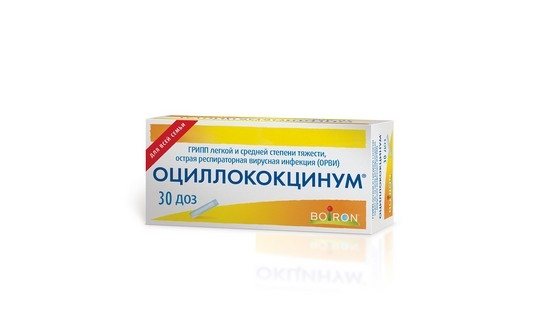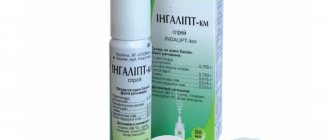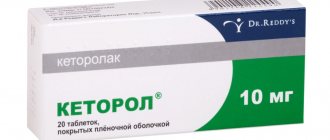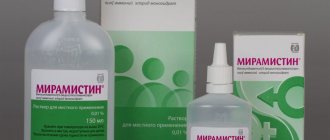Oscillococcinum during pregnancy and breastfeeding
A woman during pregnancy and breastfeeding is at great risk of catching a cold.
During pregnancy, the expectant mother's immunity decreases. This happens specifically so that a woman can bear a baby that is foreign to her body. But at the same time, with a decrease in immunity, the likelihood of contracting various infections, especially viral ones, increases. Quite often, therapy for a viral disease requires the use of an antiviral agent. But most modern medications have a negative effect on the formation of organs and systems of the fetus. In such a situation, many doctors recommend that pregnant women and nursing mothers take homeopathic medicines, most often Oscillococcinum. But still, is Oscillococcinum possible during pregnancy? Will this drug have the desired effect, and will it harm the child?
What is Oscillococcinum
Oscillococcinum is a homeopathic medicine that has an antiviral effect.
The main active ingredient of this product is the extract of the heart and liver of Barbary duck.
Oscillococcinum stimulates nonspecific resistance of the body. The drug is used in the treatment of the following diseases:
- epidemic of viral infections;
- treatment and prevention of viral diseases, in particular influenza;
- treatment and prevention of acute respiratory viral infections, which are accompanied by body aches, headache, fever, chills, myalgia (muscle pain).
A contraindication to taking Oscillococcinum may be individual hypersensitivity to its components.
The only side effect manufacturers indicate is the possible development of allergic reactions.
According to the instructions, Oscillococcinum should be prescribed by a doctor during pregnancy. Since there is no data on the safety of using this drug during this period.
During pregnancy, Oscillococcinum is taken orally, placed under the tongue and left there until completely absorbed.
The required dosage depends on the stage of the disease and the age of the patient.
To prevent illness during epidemics of viral diseases, one dose of the drug is usually taken once a week until the epidemic situation normalizes.
When the first symptoms of the disease appear, take one dose of the drug every six hours for one to three days.
At the stage of pronounced symptoms of the disease, it is recommended to take one dose of Oscillococcinum twice a day for one to three days.
This homeopathic remedy is available in the form of granules in special tubes. Oscillococcinum is produced by a French pharmaceutical company.
Is Oscillococcinum possible during pregnancy?
Judging by the instructions, Oscillococcinum can be used during pregnancy.
Another thing is that many doctors are opponents of homeopathy, so they categorically do not recommend taking this drug. Many of them claim that homeopathic medicines cannot have a therapeutic effect. They explain the positive results from taking such drugs by the placebo effect.
At the same time, there are doctors who recommend taking homeopathic medicines. Thus, Oscillococcinum in many cases actually has an antiviral effect and eliminates the symptoms of viral diseases. Taking Oscillococcinum during pregnancy, according to many experts, will not have a negative effect on the fetus
It is very important to start treatment with this drug at an early stage of the disease. Then the severity and duration of viral diseases will significantly decrease
Only a doctor should prescribe Oscillococcinum during pregnancy. This will allow you to correctly assess the woman’s condition and not miss the development of complications of the disease.
Oscillococcinum during breastfeeding
A nursing mother should take medications with caution. Once in breast milk, they enter the baby's body.
But at the same time, viruses that exist in the female body during colds enter the child’s body through breast milk. Therefore, it is necessary to treat the disease.
In such cases, mothers often wonder whether it is possible to take the homeopathic drug Oscillococcinum while breastfeeding. Most doctors answer this question positively
However, it is recommended to take it with caution and not often. The full impact of Oscillococcinum on a baby during breastfeeding has not yet been studied
It is important to remember that Oscillococcinum should only be prescribed by a doctor during pregnancy and breastfeeding.
What about contraindications?
Nursing mothers pay attention to this point. And he cannot but rejoice, because the drug has only three limitations:
- individual sensitivity to its components (and this is extremely rare);
- lactose intolerance;
- lactase deficiency.
The situation with adverse reactions is also encouraging: there is no information about such phenomena, that is, they were not recorded or turn out to be completely insignificant. But, according to the manufacturers, allergic reactions and mild headaches are still possible.
What medicine can a nursing mother take for headache pain?
Analgesics can be quite dangerous pills for nursing mothers and their babies. Some components of such drugs can cause an allergic reaction, diarrhea or sleep disturbances in children. To avoid trouble, you should not choose your own pills. Head pain can be caused by many factors, so medications should not be taken “at random”
It is important to know exactly how the drug will work and whether it will be safe for the baby
- Ascophen is a combination of acetylsalicylic acid, paracetamol and caffeine, so these tablets help cope with headaches caused by fatigue and low blood pressure. But, as you know, Aspirin cannot be taken during lactation, and caffeine can negatively affect the baby’s condition. Therefore, if a nursing mother wants to take Askofen, she will have to stop feeding for the entire period of therapy (and even a few days longer). This medication should not be taken for more than five days in a row.
- Analgin is a tablet that is strictly prohibited for use by nursing mothers. Analgin is a toxic drug, which has already been confirmed by many studies. It is capable of disrupting the structure of milk, interfering with hematopoietic processes, and disrupting the functionality of the urinary system. In addition, Analgin changes the blood picture: it is unsafe to take it even for a relatively healthy person.
- According to the instructions, Nimesil, or Nimesulide, should not be used during breastfeeding. But in practice, doctors allow you to take a pill once, although you should stop feeding for one day. The process can then be resumed.
For headaches associated with cerebral vascular spasm, you can take No-shpu - this will not have any negative effect if the tablet is taken by a nursing mother once, in the amount of one piece. If long-term treatment with No-shpa is planned, then the woman will have to temporarily stop the feeding process in order to avoid the toxic effect of the medication on the child’s body. By the way, there is no particular difference between the No-shpa and Drotaverine tablets. These drugs are considered analogues of each other.
If a headache in a nursing mother is associated with increased blood pressure, with spasm of cerebral vessels, then you can take the relatively safe tablet Papazol, which is a combination of dibazole and papaverine. If you take Papazol once, you only need to express the portion of milk that follows after taking the tablet - that is, skip one feeding, replacing it with pre-prepared milk or formula. There is no need to make any other changes in feeding the baby: you can then breastfeed as before. But with long-term and regular use, lactation must be suspended.
Why Oscillococcinum?
This drug has been sold in pharmacies for several years now. It can be purchased freely without a doctor's prescription. Oscillococcinum is an effective homeopathic remedy that is often prescribed by doctors to treat flu and cold symptoms, which is why almost every woman took it during pregnancy or breastfeeding. Its peculiarity is considered to be a mild effect on the human body, so the drug has no contraindications for pregnant and lactating women. In addition, Oscillococcinum is often prescribed to young children.
However, not everyone believes that this product is so safe that it can be used during pregnancy and breastfeeding. In addition to discussions regarding whether Oscillococcinum can be taken while breastfeeding, there is a lot of discussion about the effectiveness of the drug.
Some doctors, who are more inclined to traditional therapy, call oscillococcinum an ordinary dummy that can only give a placebo effect. Thorough studies of the drug did not show a single active ingredient in its composition that could be truly useful for influenza. Thus, we can say that this remedy has an extremely gentle effect on the body, that is, it will not be dangerous during lactation.
Experts who welcome homeopathy believe that Oscillococcinum is a miracle remedy that can quickly eliminate cold symptoms, and when taken periodically, become an excellent preventive measure during seasonal epidemics.
If you look in more detail, it turns out that this product really does not contain any components that could be dangerous for the baby. In addition, taking the drug completely eliminates the possible occurrence of negative side effects. In the instructions for the medicine you can see that it consists of sucrose, lactose and musky duck liver extract. Thus, among the contraindications, only individual intolerance to the components of the product is noted. In extremely rare cases, Oscillococcinum causes allergies.
Use during breastfeeding: is it possible or not?

Canephron during lactation is prescribed strictly according to a doctor’s prescription and in cases where the therapeutic benefit for the mother outweighs the risk of possible complications for the child. In practice, if the recommendations for taking the drug are followed, no adverse reactions have been recorded in nursing mothers.
In case of infections and acute inflammations of the genitourinary system, it is not possible to suppress the proliferation of bacteria without antibiotics. If earlier antimicrobial treatment included refusal to feed, today Canephron has eliminated this problem. The safe composition allows Canephron to be prescribed during pregnancy and breastfeeding.
The medicine is used in the form of pills, since the alcohol in the tincture passes into breast milk. The content of the active concentrate in 2 tablets is equal to 50 ml of drops. A course of treatment requires 180 capsules, packages are sold in 60 and 120 pieces (20 in 1 blister).
Admission rules
- 2 tablets 3 times a day.
- Drink 200 ml of water.
- The course of treatment is 4-8 weeks.
- Drink 1.5-2 liters of water daily.
According to the instructions for use, the effect of Canephron does not depend on the time of food intake. The effect of therapy occurs after 2-3 weeks. Stopping treatment during this period will nullify the effect of the regimen; 3-4 days of absence are an indication for repeating the course.
Even in a short time, bacteria multiply with renewed vigor, causing complications. For example, untreated cystitis in half of the cases develops into acute pyelonephritis, requiring antibiotic therapy.
After taking the morning dose of the drug, evaluate: the condition of the baby’s skin, appetite, anxiety. The list of side effects includes an allergic reaction, so at the first sign of redness and itching, stop taking Canephron.
Is Oscillococcinum possible while breastfeeding?
Oscillococcinum during breastfeeding is often used by young mothers for the treatment of viral diseases.
Effective medicine or a dummy?
Oscillococcinum has been successfully sold in pharmacies for several years. Doctors prescribe the drug quite often, mainly to mothers, breastfeeding and pregnant women. In many situations, the drug is recommended for the treatment of children. However, controversial discussions regarding the effectiveness of its use regularly develop around the drug.
Experts practicing official medicine are convinced that Oscillococcinum is a drug that has no medicinal properties, since research has not revealed any active ingredients in its composition. This medicine can be used during breastfeeding.
Supporters of homeopathy are confident that Oscillococcinum is a wonderful remedy with good results in the prevention of various colds. And if you use the drug in the first stages of the disease, it is possible to quickly and effectively cope with the manifestations of influenza and acute respiratory infections, significantly alleviating the symptoms of the disease.
The medicine does not contain dangerous components, and it does not have a harmful effect on the body of a nursing mother. The developers claim that the composition of the drug Oscillococcinum includes:
- Muscovy duck liver extract;
- cane sugar;
- milk sugar (lactose).
Among the contraindications, one can single out only individual intolerance to certain substances that make up the medicine. In exceptional situations, minor allergies may occur.
How does the drug work?
The effect of homeopathic remedies is that they control the protective functions of the human body. In other words, the appearance of any complications forces the immune system to produce a larger number of active cells, that is, to fight the disease.
Several years ago, scientists came to the conclusion that oscillococci contribute to the development of colds. And recently it was revealed that the largest accumulation of this type of bacteria is present in the liver of the musky duck. Based on the extract from this organ, the drug Oscillococcinum was created.
Ingestion of the extract, which contains the required number of bacteria, into the body activates the patient’s immunity in a short period of time.
This is what distinguishes it from other medications, which contain anti-inflammatory substances that alleviate the symptoms of the disease.
Use of the drug during breastfeeding
The dosage of Oscillococcinum is prescribed to each breastfeeding woman individually. The description of the drug states: during lactation and pregnancy it should be taken after consultation with your doctor. Before starting treatment, you should definitely visit a doctor, he will prescribe a course of therapy.
Oscillococcinum is produced in the form of round-shaped and white dragees; they have no taste or smell. The contents of the dose should be placed under the tongue and held until it is completely dissolved. The medicine is recommended to be taken before meals (15 minutes before) or one hour after.
The dosage of the medicine is different for each patient, but on average it is:
- For the purpose of preventing ARVI or influenza - 1 dose 1 time every 7 days during the period of ARVI spread;
- In case of the first symptoms of the disease - 2 doses per day with a time interval between doses of at least 6 hours;
- during the advanced stage of the disease - 1 dose in the morning and in the evening for 3 days.
The course of treatment depends on many circumstances and is prescribed by the doctor
And since the safety of the drug Oscillococcinum has not yet been fully studied, women should be careful during breastfeeding
Homeopathic doctors assure that during lactation, Oscillococcinum is considered the best option when choosing a medicine for a cold.
Unlike other medications, it does not contain harmful components, it does not pose any danger to nursing mothers. However, like any other medicine, Oscillococcinum does not help everyone.
Most mothers who took this remedy claim that the result is observed only in the first two days of the disease.
According to experts, it is better to use Oscillococcinum as a prophylactic against influenza and ARVI. The components of the drug activate the immune system, and all signs of the disease will leave the body quickly enough, and the mother will be able to return to her normal lifestyle.
Skripnik Oksana
Use during lactation: brief instructions
Since Oscillococcinum does not contain harmful components, doctors agree that it is completely harmless during breastfeeding. However, the dosage should be selected individually. The instructions for the drug say that during lactation and pregnancy it can only be taken with the consent of a doctor. Therefore, before using the medicine, you should definitely consult a specialist.
Oscillococcinum is a round, white, tasteless and odorless granule. According to the instructions, the tablet should be kept under the tongue until it is completely dissolved. It is recommended to take the medicine 15 minutes before a meal or an hour after a meal.
The dosage of the drug depends on the individual case and on average is:
- To prevent colds or flu - 1 dose per week;
- At the first signs of illness - 2 doses per day with an interval between doses of at least 6 hours;
- For severe flu or cold symptoms - 2 doses per day (morning and evening) for 3 days.
The duration of treatment may depend on many factors and is determined by the attending physician. Although Oscillococcinum does not cause side effects, its safety has not yet been fully studied, so mothers should be extremely careful.
Homeopaths say that during breastfeeding the best remedy for colds is Oscillococcinum. Unlike ACC, Bromhexine, Ambroxol and other drugs, it does not contain harmful components, therefore it is absolutely safe during lactation. But, like any other remedy, Oscillococcinum does not help everyone. Many women who have experienced the effects of the medicine say that it is most effective only in the first two days of the disease.
It is best, according to doctors, to take the drug as a preventive measure for influenza and colds. The substances contained in it activate the immune system, which can independently cope with flu and colds. The disease will pass quickly and unnoticed, and the mother will be able to return to full communication with her baby.
Features of reception during breastfeeding
For prevention purposes, it is allowed to drink one tube per week. If treatment is carried out with the help of a drug, it should be taken every three hours. The dosage can be increased only after consultation with your doctor.
We suggest you read: Is it possible to get pregnant with guards. How to get pregnant while breastfeeding?
The drug does not pass into breast milk, so feeding is carried out as before. Mommy is not recommended to boil it additionally or replace it with an artificial mixture.

Only a doctor can make a prescription
Additionally, it is recommended to monitor the condition of the baby’s skin. If negative effects are detected, the drug should be discontinued immediately.
This homeopathic medicine is used as a prophylactic against viral and respiratory diseases. It is recommended to take it during a severe flu epidemic. It is advisable to receive all family members at once. Even children and pregnant women are not included in the exception.
In order for the effect of using the drug during natural feeding to manifest itself quickly, it is necessary to use Oscillococcinum correctly during lactation. Many mothers note that they did not feel the therapeutic effect of the drug, but doctors say that this is due to the late start of treatment.
If during breastfeeding a woman notices chills, fever, headaches, muscle and joint pain, she is recommended to take one dose of the drug and observe the body's reaction. In the absence of an allergic reaction and good tolerance, after 6 hours, take another portion, and then a third. The doses and rules of administration are described in detail below.
When taking medications, it is important to adhere to the correct dosage
The instructions for use of Oscillococcinum describe in detail the method of using the drug, but how to take it correctly during breastfeeding? Oscillococcinum round tablets should be taken a quarter of an hour before meals, or an hour after eating. To achieve a quick and maximum therapeutic effect, the tablets are not swallowed, but dissolved under the tongue.
It is not advisable to determine what dosage is needed in a particular case on your own, because during breastfeeding you can inadvertently harm the baby. However, the usual doses presented in the instructions are:
- 1 tube of the product per week, if taken for preventive purposes;
- 2 tubes per day with a break of 5-6 hours between doses, if the disease has just begun and has passed no longer than two days;
- 2 tubes every day if the cold is severe and the course of taking the drug should last at least three days.
https://www.youtube.com/watch?v=TcudBDXzQiY
Whether or not to drink Oscillococcinum during lactation and breastfeeding is up to each woman to decide for herself. If the doctor believes that the prescription of the drug is justified, and the effect against colds is noticeable, then one should not refuse a safe and successful method of therapy
Women with hypersensitivity to sucrose and lactose included in the composition should pay special attention to the intake, monitoring the body’s reaction and discontinuing the drug if unexpected effects develop
Tags: time, breast, disease, feeding, treat, Oscillococcinum, colds
About the author: admin4ik
« Previous entry
Can I take Paracetamol while breastfeeding?

Many studies have shown that paracetamol and breastfeeding can be combined. It is approved for nursing mothers and children over 3 months of age. Before taking paracetamol, consult a healthcare professional.
Monitor your baby's reaction, sometimes allergies are possible - hives, itching, skin rash
Pay attention to your child's digestion. In rare cases, heartburn, belching, stomach rumbling and diarrhea may occur.
Do not worry, adverse reactions when taking paracetamol during lactation are very rare. In most cases, this is due to an overdose of the drug and non-compliance with the instructions.
How long does it take for paracetamol to be excreted from breast milk?
Despite the safety of the drug, it is necessary to weigh the expected benefits of treatment for the mother and the possible risks for the baby. The possibility of using paracetamol by a nursing mother is decided in each specific case by the attending physician. The drug is contraindicated for newborns.
9 rules of admission for a nursing mother
There are specific instructions for using paracetamol. Following the recommendations allows you to achieve the maximum effect of the drug and avoid adverse reactions.
It is especially important for a nursing mother to adhere to the following rules:
- Dosage for a nursing mother: 500 mg up to 4 times a day.
- The maximum duration of treatment is 3 days.
- Feed your baby breast milk before taking the medicine.
- Before the next feeding, at least two hours should pass, preferably four.
- Do not take more than 1 g (2 tablets) at a time, or more than 4 g per day.
- Use the minimum effective dose that is right for you. You may only need one tablet a day to get the effect.
- Take the tablets with plain water, no coffee or tea.
- Do not take paracetamol during breastfeeding at the same time as ibuprofen and/or aspirin.
- Naturally, no alcohol.
Interaction with other drugs
The compatibility of paracetamol with other drugs is the subject of many studies:
- Use with activated carbon: the amount of paracetamol reaching its site of action in the body is reduced.
- With a contraceptive: the analgesic effect of paracetamol is reduced and its removal from the body is accelerated.
- With diazepam: the elimination of diazepam from the body is slowed down.
- With isoniazid: the toxic effect of paracetamol increases.
- With metoclopramide: the absorption of paracetamol increases, its concentration in the blood increases.
Can a nursing mother drink oscillococcinum, and how should it be taken according to the instructions?
No one is immune from infection or hypothermia. And then panic usually begins - what to do? Continue feeding? Or isolate yourself from the child and stop breastfeeding? How to treat?
Previously, the answer to all these questions was unequivocal - isolate the child from the sick mother and intensively treat the latter. Fortunately, modern medicine is not so categorical. The woman is offered to be treated with the safest drugs and homeopathy that do not cause significant harm to the child. What about breastfeeding - it is believed that weaning a child is not only unnecessary, but also unjustified. After all, with breast milk, the baby receives antibodies to the disease from the mother.
And yet, how to treat if an acute respiratory infection or influenza strikes at the most inopportune moment? In the last few years, a new homeopathic medicine with the complex name Oscillococcinum has appeared on pharmacy shelves. It is prescribed by some doctors, especially to pregnant and lactating women, as well as children.
There are controversial discussions surrounding this drug regarding its effectiveness. Adherents of traditional medicine call Oscillococcinum a dummy with a placebo effect, since during its research no active ingredients were found in its composition.
Adherents of homeopathy talk about the miraculous nature of the drug, which, when taken regularly, helps prevent colds. And when taken in the early stages of the disease, Oscillococcinum helps fight the first signs of colds and flu, significantly alleviating them.
Be that as it may, the drug does not contain dangerous components and has no side effects. It contains only lactose, sucrose and, according to manufacturers, extract from the liver of Barbary (muscovy) duck. The only contraindication is individual intolerance to the components of the drug. Sometimes allergic reactions to the drug are observed.
Can a nursing mother have Oscillococcinum?
Since the drug does not contain harmful ingredients, Oscillococcinum is not prohibited during breastfeeding. Moreover, it is Oscillococcinum that many doctors prescribe to nursing mothers. It is not dangerous, since it does not contain anything that, if absorbed into milk, would harm the child.
The instructions for Oscillococcinum state that during pregnancy and lactation the drug should be prescribed by a doctor. Therefore, you should not make self-prescriptions, even considering its obvious safety. There, in the instructions, it is indicated that treatment with Oscillococcinum does not exclude the use of other drugs.
Oscillococcinum during lactation is a drug that can be safely taken for the purpose of prevention, as well as for the treatment of viral diseases. If you want to use it as a preventative, you need to take it regularly, especially in winter. In this case, manufacturers promise that it prevents the occurrence of influenza and ARVI.
Method of administration and dosage of the drug
It is necessary to place the contents of the dose container under the tongue and keep it there until completely dissolved. For infants, the contents of the dose are dissolved in a small amount of water and given using a bottle with a nipple or from a spoon.
It is recommended to take the drug 15 minutes before or 1 hour after meals. As for the dosage, it depends on the specific case (but not on the age of the patient). For example, for prevention you need to take 1 dose per week, at the initial stage of the disease - take 1 dose and repeat a couple of times after 6 hours. In advanced stages of the disease, you should take the drug twice a day, 1 dose for one to three days.
Is it safe for nursing mothers?
Since this medicine does not contain dangerous or harmful ingredients, it is not prohibited during lactation.
Moreover, this is the remedy that many doctors prescribe during breastfeeding. It does not pose any danger, because it does not contain those substances that can be absorbed into milk and cause harm to a nursing baby. However, it is important to note that the instructions for this medicine state that during breastfeeding it should be prescribed by the attending physician. This suggests that young mothers should not self-medicate, even given the fact that the safety of Oscillococcinum is obvious
In addition, the instructions state that treatment with this medication does not exclude the use of other medications during lactation.
Homeopathy: quackery or not?

The basis of patients' doubts about the idea of homeopathic treatment. At least a third of scientists deny science as going beyond physics, biology and chemistry - the three pillars of medicine. Other experts remain on the sidelines of the discussions, smiling meaningfully. Adherents of homeopathy present their arguments.
Opinions for and against:
- Recognition in 70 countries, including Russia.
- In 50% of countries, homeopathy treatment is paid for from compulsory medical insurance funds.
- It is recognized as the official medical system in India.
- Research by pharmacologist N.P. Kravkov confirmed that the body reacts to the substance at a concentration of –12 M.
- World science has recognized the structural-informational property of water (it supports the multiple dilution technique).
- Harmlessness of Oscillococcinum during lactation for infants.
- Transparency and the right to choose – the principle of action is indicated on the drug.
However, there is little evidence for the effectiveness of homeopathy as an effective treatment for any specific health condition.
Bibliography:
- Homeopathy – by NCCIH (published 04/30/2012).
Oscillococcinum during breastfeeding: can a nursing mother take it or not during lactation?
During the period of breastfeeding, a young mother can afford a very small list of approved medications for colds or flu. Most therapists prescribe Oscillococcinum during breastfeeding; whether it is possible or not is a question that interests nursing. Whether it is capable of harming the baby and its mother - we will find out in the article.
Properties and principle of operation
Oscillococci cause colds. Most of them are concentrated in the liver of a duck called musky. The extract of these microorganisms served as the basis for the creation of the drug Oscillococcinum.
It is a homeopathic medicine, its components increase the body's defenses. Thus, it can be argued that this remedy reduces the risk of colds.
Unlike other antiviral drugs, Oscillococcinum does not contain an antiseptic, therefore it is allowed during pregnancy and lactation, even for young children
It is very important to take it in the necessary and correct dose
It should be noted that the instructions included inside the drug do not describe exactly how the medicine works. The medication has virtually no contraindications, except for allergies to sucrose and lactose.
Not all experts recognize this medicine, as they consider it a dummy. However, Oscillococcinum during breastfeeding in our country is very actively prescribed by therapists.
The drug contains no harmful components that would adversely affect the body of a pregnant, nursing mother or her child. ACC or Bromhexine are considered the most productive, but their use is prohibited during breastfeeding.
Considering the fact that this drug is considered the safest, many mothers do not visit a doctor at the first signs of illness and prescribe the drug themselves. This is completely wrong! Only the doctor sets the required dosage and gives all the necessary recommendations.
Is it possible during lactation?
Many experts prescribe Oscillococcinum to young mothers, since it has virtually no contraindications or dangerous components in its composition. But, despite all this, a woman should not prescribe this drug on her own, much less the dosage; this can have serious consequences for the baby, since the components of the drug are absorbed into the blood and enter breast milk.
Breastfeeding women are allowed to take Oscillococcinum without fear both for illnesses and for prevention. Some experts even insist that in winter and early spring, late autumn, young mothers take the prescribed dosage of the medicine for preventive purposes.
How to take it correctly during breastfeeding?
Is Oscillococcinum suitable for a nursing mother? We have already figured it out. But how to take this drug correctly during lactation?
White tablets or tubes are usually taken a quarter of an hour before or after a meal. The maximum effect is achieved if the tablet dissolves under the tongue.
If prevention is necessary, a nursing woman should limit herself to one tablet per week. For colds and flu, in the first two to three days you should take no more than 2 pieces per 24 hours. The interval between doses is usually 6-8 hours. In the case when the cold has persisted, you need to take it in the same amount (2 pieces per day) for at least three days.
Doctors today have not yet come to a general conclusion whether Oscillococcinum is really such a miracle drug for nursing mothers and other categories of people or is it just a dummy? It contains no active components, as well as harmful components. According to reviews from users, especially young mothers, this drug can be called effective if taken immediately at the time of illness or for prevention.
During lactation, doctors have the right to prescribe women a not so large list of medications during colds. Oscillococcinum is considered the most popular. This is a homeopathic remedy, so there is a lot of controversy surrounding its effectiveness. The medicine is considered completely harmless, it has virtually no contraindications.
You will learn more information about this drug from our video.
Homeopathy against influenza: safety plus/minus effectiveness?

A homeopathic remedy with the complex name “Oscillococcinum” is now actively offered in pharmacies to young mothers whose children are breastfed. It should protect women at risk from seasonal viruses and eliminate the unpleasant symptoms of such diseases in just 2-3 days. What kind of miracle drug is this?
It is produced in France and used in 50 countries. Unlike other homeopathic remedies, manufacturers received a patent for it, which immediately affected its cost: the drug is quite expensive - from 750 rubles. It contains an extract from the heart and liver of the musk duck - this is the main active ingredient. Why should she destroy the virus? The developer of this product discovered that it contains antibodies that produce a double effect - they stop the spread of the virus and spur the body's defense response. Oscillococcinum also contains two auxiliary components - sucrose and lactose, their function is the delivery of antibodies inside the cells.
When breastfeeding, as indicated in the instructions, it is advisable to take Oscillococcinum during epidemics, so as not to catch the virus, as well as at the very first signs of the disease. However, many doctors question the effectiveness of this remedy, directly calling it a “dummy”.
Thus, Professor Vasily Vlasov, a member of the Society of Evidence-Based Medicine Specialists, not only criticized its therapeutic and preventive abilities, but even doubted its safety, and gave impressive arguments. However, some doctors still recommend this remedy, although they confirm that the results of its clinical studies are very mixed. In addition, the manufacturer has not provided any clarification regarding the mechanism of action of the drug.
What medications can breastfeeding mothers take for influenza, ARVI and colds?
Viral and microbial infections are dangerous, first of all, because they have a high probability of complications. In addition, not all tablets are indicated for nursing mothers.
The first thing the doctor will suggest to a woman is to drink plenty of fluids. You can drink herbal tea, breast milk, various fruit drinks (if the baby is not allergic to berries) and just clean warm water.
Symptomatic treatment is allowed. For example, to lower the temperature, you are allowed to take Paracetamol or Nurofen tablets (by the way, you should completely forget about Acetylsalicylic acid during the feeding period).
Let's consider other common pills, the use of which raises many questions among nursing mothers:
- Ingavirin - this medication blocks the intracellular penetration of the virus and inhibits its reproduction processes. It is usually taken for treatment or prevention. But it is not advisable for nursing mothers to take this medication. The only possible option is to stop breastfeeding for the entire period of treatment. Ingavirin, after entering the baby’s bloodstream, can cause dizziness, tachycardia and many other extremely undesirable symptoms.
- Arbidol is a drug of an artificially created prototype of human interferon, which accelerates recovery and significantly alleviates the symptoms of a viral disease. However, experts do not have information about whether such tablets can be taken by nursing mothers: experiments with Arbidol were carried out only on animals. And, although such experiments have shown the relative safety of the drug, no one can accurately answer the question about the possibility of taking it during lactation. What you definitely don’t need to do is treat yourself. Treatment with Arbidol should be discussed with your doctor, and the sooner the better. After all, interferons should be taken at the first symptoms of ARVI. If you are late in taking the first tablet, then further treatment with Arbidol will be pointless.
- Anaferon are tablets containing antibodies to γ-interferon. The drug has a pronounced antiviral effect and is approved for use by nursing mothers: its main abilities are to prevent the development of complications and accelerate recovery. Most nursing women and their babies tolerate Anaferon well. Allergy to the drug is observed only in isolated cases. The main thing is to comply with the recommended dosage: immediately after painful symptoms are detected, take one tablet every half hour, and so on for two hours;
- then throughout the day, take one more tablet every three hours;
- on the next day and thereafter, take one tablet in the morning, at lunch and in the evening - that is, three times a day.
The duration of the treatment course is determined by the doctor individually.
- Antigrippin is a combination drug based on paracetamol, chlorphenamine, ascorbic acid and other components. The tablets have a pronounced anti-inflammatory, antipyretic and antihistamine effect: the main signs of a viral infection disappear in a short time, and recovery is accelerated. However, doctors do not recommend taking Antigrippin to nursing mothers, since these tablets are quite toxic to the child’s body. If there is an urgent need for treatment with such tablets, then lactation is interrupted.
- Oscillococcinum is a homeopathic remedy that can safely and effectively counteract viral invasion. The composition of the drug is simple and consists of an extract from the liver and heart tissues of Barbary duck, as well as sucrose and lactose. It is recommended to take the tablets immediately after the first symptoms of the disease are detected, a quarter of an hour before meals, or between meals. During the first day, three doses of the drug are taken with an interval of six hours between doses. Over the next 24 hours, you should take one dose every twelve hours. Prophylactic use consists of taking one dose daily at the same time for one week. Tablets (granules) are kept in the oral cavity until completely dissolved.
Despite the relative safety of Oscillococcinum, nursing mothers are allowed to take tablets only after talking with a doctor. Still, the possibility of an allergic reaction cannot be ruled out, both in mother and baby.
Is it possible to take the drug during breastfeeding?
The mother’s immunity also needs support because she has a long breastfeeding process ahead of her. Every young mother during lactation tries to do everything to protect herself from the flu and colds. But the disease can still strike without warning, and you should be prepared for this.
Previously, doctors insisted on urgent isolation of the sick mother and cessation of lactation during treatment. Today it is believed that during illness, a woman’s body produces special antibodies that help the baby not get infected due to the fact that they pass to him with milk.
These antibodies are important for the formation of the child’s immune system. Therefore, modern women try not to stop breastfeeding in case of a mild illness, because now for treatment you can choose a drug that is safe for mother and baby. One such drug is Oscillococcinum.











